Arborvitae can often be seen in city parks and squares, in garden plots as hedges, in plant compositions and as tapeworms.
|
These plants are increasingly used by landscape designers for landscaping gardens and parks. |
To make it easier to navigate the abundance of varieties, we have prepared a selection of the most popular and beautiful varieties of thuja with descriptions, characteristics and photos of each plant.
| Content:
|
Review of unusual varieties of thuja from Natalia Samoilenko
Pyramid varieties of thuja
The best varieties of pyramidal thuja and their variegated (variegated) forms allow you to diversify the landscape design of your garden. Thuja pyramidalis is a variety of thuja occidentalis, which in the wild can grow up to 35 m. The height of cultivated varieties, as a rule, does not exceed 12-15 m.
Thanks to frost-resistant varieties, pyramidal thujas delight gardeners not only in the Middle Zone, but also in the North-West of the country, the Urals and Siberia.
Smaragd
|
This is one of the best varieties of thuja. The crown is narrow-pyramidal, dense, symmetrical. The needles are emerald green and do not change color in winter. The cones are colored brown. |
- The height of an adult specimen is 4-6 m, the diameter is up to 2 m. The branches grow upward.
- It does not grow rapidly (no more than 10-20 cm in height and no more than 5 cm in width per year).
- Prefers fertile soils and regular watering, does not tolerate drought and stagnant moisture.
- Frost resistance -35 °C, climate zone 4. Smaragd is characterized by high winter hardiness in the middle zone and resistance to unstable climatic conditions.
- A variety of universal use. An ideal solution for creating a hedge.
The slow growth rate allows you to trim much less frequently than other varieties.
Spotty Smaragd
|
A variety of the popular variety Smaragd. This thuja looks especially impressive next to dark green conifers. |
The crown is conical and looks decorative due to the milky inclusions randomly scattered on the light green background of pine needles.
- The height of an adult specimen is 3 m, diameter is 1 m.
- Annual growth in height is about 10 cm, in width – up to 4 cm.
- Prefers fertile soils and is shade-tolerant.
- Frost resistance -35 °C, zone 4. Grows without shelter in areas with temperate climates.
- Suitable for single and group plantings, creating hedges.
The variety is resistant to air pollution.
Rosenthalii
|
The variety is compact, with short, dense, straight shoots, characterized by slow growth and high frost resistance. The crown is narrow, pyramidal. |
- The height of an adult specimen is 3.5-5.5 m, diameter 0.8-1 m.
- It grows by 10-12 cm per year. The height of a 30-year-old plant is 2.5-3 m.
- Grows well on fertile loams. Drought resistant.
- Frost resistance -35°C, zone 4 (Middle Russia, Urals, Far East).
- It fits organically into plant compositions and is indispensable in the design of hedges.
It tolerates pruning and shearing well.
Pyramidalis Compacta
|
A tree with a very compact, pyramidal crown, with several vertical trunks (1-3). The shoots are elastic, slightly twisted. |
The needles are green, green-brown in winter, and have a bluish tint in young seedlings. Thuja Pyramidalis Compacta is frost-resistant, but in the spring it suffers from sunburn and requires shelter.
- The height of an adult plant is 5–10 m, diameter is 2–4 m.
- Over the course of a year it grows by 22-26 cm. At 10 years of age, the height of the plant is 2.2-2.6 m.
- Prefers moderately moist, well-drained soils.
- Frost resistance - 40°C, zone 3 (Middle zone, Urals, Far East, Siberia).
- In addition to being used in hedges, it often acts as a tapeworm.
Very often, this variety of thuja is used to create a high hedge that covers the entire area from prying eyes.
Brabant
|
Frost-resistant, shade-tolerant and fast-growing thuja variety. The needles retain a bright green hue all year round. The branches are short, thin, raised. One of the most unpretentious varieties. |
- The height of an adult plant in the middle zone is 5 m and the diameter is 1.5 m.
- Over the course of a year it grows 30-35 cm in height and 15 cm in width.
- Can grow in shade and sun. Does not tolerate temperature changes in spring that damage wood. Prefers to grow in fertile, moist soil.
- Frost resistance -35 °C, zone 4 (Moscow region, Leningrad region, Ural).
- An excellent solution for hedges if you need the fastest possible results.
To maintain the pyramidal shape, pruning is necessary.
Golden Brabant
|
The beautiful Golden Brabant variety is a golden yellow variant of the famous Brabant variety. Fast-growing cone-shaped conifer. Golden needles retain their color in winter and summer. |
- The height of an adult plant in the middle zone is 3-4.5 m, diameter up to 1.5 m.
- In a year it grows 30 cm in height and 10 cm in width.
- Prefers moist, fertile soils. Does not suffer from sunburn.
- Frost resistance -35 °C, zone 4 (Moscow region, Leningrad region, Ural).
- Used in single and group plantings, in the design of alleys and hedges.
Spiralis
|
The distinctive features of Thuja occidentalis Spiralis are short, helical shoots, twisted like a spiral. |
The needles are dark green with a blue or bronze tint. The variety is winter-hardy and fast-growing. The crown grows unevenly, so the plant needs constant pruning and shaping.In young plants the crown is narrow and loose, but with age it becomes denser and expands.
- The height is 10-15 m with a crown diameter of 2-3 m. If sanitary pruning of the lower part of the crown is not carried out, its diameter can reach 3 m.
- During the year it grows by 26-32 cm. The height of a 10-year-old tree is 3 m, diameter is 0.7 m.
- Prefers a sunny or semi-shaded place, the soil is fertile and moist.
- Frost resistance -37°C, zone 3. The plant can be confidently planted in regions with harsh climatic conditions, as well as in environmentally unfavorable areas. Ephedra quickly adapts to polluted air and will help improve the overall condition of the environment.
It is used in pharmacology, as the plant has antiseptic, hemostatic and expectorant properties. And also - traditionally, for landscaping garden and park spaces.
Wareana
|
The crown is dense, narrow pyramidal. Numerous branches are thin and soft. The needles are light green or yellow in summer, brown in winter. |
- The height of an adult plant is 7 m, diameter is 2.5-3 m.
- The annual growth is 20-25 cm in height, 15-20 cm in width.
- It grows better in the sun, loosens in partial shade, but does not lose the shape of the crown.
prefers evenly moist, well-drained soils. - Frost resistance - 36 °C, zone 3 (overwinters without shelter in most regions). The variety is very resistant to winter-spring burns and winds.
- It is used in the arrangement of parks and house alleys.
Ellwangeriana
|
A variety of thuja with a crown shape in the form of a wide cone. In winter, the needles are grayish. It grows slowly. Excellent for trimming and shaping. |
- The height of an adult plant is 2-3 m, diameter is 1.5 m.
- Annual growth 15-20 cm
- It develops better on fertile loams.It is photophilous; for planting it is recommended to choose bright areas with light partial shade.
- Frost resistance -35 °C, zone 4 (Moscow region, Leningrad region, Ural).
- Used for planting hedges.
In winter, the branches are tied or covered with a snow-protective frame so that they do not break off under the weight of snow.
Sunkist
|
This is the best shrub that has a conical shape and golden yellow needles. It grows very slowly. |
This plant does not require pruning. The needles are large, golden-yellow in color. In winter, the needles take on a bronze tint.
- The height of an adult plant is 4–5 m, diameter is 1.5–2 m.
- Annual growth is 10 cm. Over 10 years it reaches a height of about 3 m and 1 m in diameter.
- Prefers nutritious and moderately moist soil, wind-resistant. The place is preferably sunny or light partial shade.
- Frost resistance - 34°C, zone 4 (Middle zone, Siberia, Far East).
- Sunkist is ideal for hedges.
The variety lends itself well to shearing, which allows you to give the specimens the appearance of various geometric shapes.
Kornic
|
A small, fast-growing coniferous tree with a conical shape. A characteristic feature of the variety is the bright yellow shoots of the current year. Later the needles become light green, as in the photo, and in winter they turn bronze. |
A small, fast-growing coniferous tree with a conical shape. A characteristic feature of the variety is the bright yellow shoots of the current year. Later the needles become light green, as in the photo, and in winter they turn bronze.
- The height of an adult plant is 2-3.5 m and the diameter is up to 1.6 m.
- Annual growth is 13 cm. At the age of 15 it reaches a height of 2 m and 0.8 m in diameter.
- Prefers fertile and moist soils. Does not tolerate drought well and needs constant moderate watering.
- Frost resistance -35°C, zone 4 (regions of Siberia, Urals, Far East).
- Most often in landscape design, these trees are used to make hedges that can protect the area from wind and dust.
Yellow Ribbon
|
The most valuable variety of thuja with golden colored needles. The shape of the plant is narrow pyramidal. The crown is dense due to a large number of densely located branched shoots. |
- The height of an adult plant is 2.0 - 2.5 m and the diameter is 0.8 m.
- Annual growth is 10-12 cm.
- Wind-resistant, unpretentious to the soil, does not like stagnant moisture. Prefers light partial shade or morning (evening) sun for 6-8 hours.
- Frost resistance -35°C, climatic zone 4 (regions of Siberia, Urals, Far East).
- The tree is suitable for making hedges and for urban landscaping, as it does well in areas with unfavorable ecology.
Does not suffer from spring sunburn, but young (up to 2 years old) plants are recommended to be protected from the bright spring sun.
Columnar varieties of thuja
Columnar representatives of the western thuja grow up to 20 m in height in the wild, but in central Russia the plant can reach 10 m in rare cases, but more often no more than 3 m. The evergreen plant has a pronounced coniferous smell, amazing density of needles, interesting shape and is distinguished by its unpretentiousness.
Columna
|
A popular variety that attracts gardeners with its unpretentiousness and beautiful columnar crown shape. |
The needles are bright green. In the cold season, the needles darken somewhat, especially in areas with a more severe climate.
- The height of an adult plant is 6-9 m and the diameter is 1.5 m.
- Annual growth is 15-20 cm.
- Prefers fertile soil with moderate humidity. Does not tolerate drought well; the ideal location is in partial shade.
- Frost resistance -30°C, zone 4 (Northwest of the country, Urals and Siberia).
- The columnar shape allows Columna to be used for decorating hedges with an interval of 0.5–0.8 m between plants and for creating alleys.
Fastigiata
|
Fast growing columnar thuja. The branches are tightly pressed to the trunk, the needles are soft, from light to dark green with a strong pine smell. |
The color of the plant does not change in winter. Tolerates shaping haircut well.
- The height of an adult plant is 10-12 m (in the middle zone - 6 m), diameter is 3 m.
- Annual growth is 30 cm.
- Prefers sunny and semi-shaded places with moist, fertile soils.
- Frost resistance -36°C, zone 3 (Moscow region, Siberia, Ural). It is not damaged by sunburn and frost even in harsh winters.
- A good option for creating living fences.
The variety is long-lived, lives up to 200 years.
Holmstrup
|
One of the best conifers with a dense columnar shape, which is distinguished by its ease of care and beauty. |
The needles do not change color throughout the year and remain rich green. The crop occupies a minimum of free space on the site and does not interfere with the development and growth of other green spaces.
- The height of an adult plant is 3-4 m, diameter is 0.8-1 m. The crown is dense with highly branching shoots. The bark is red-brown in color, less often there is a gray tint.
- The annual growth is no more than 15 cm. To reach a height of 1.5-2 m, the thuja requires at least 10 years.
- Prefers well-moistened, fertile, loose soil. When grown in illuminated areas, the crown is denser and denser.
- Frost resistance –39 °C, zone 3 (can be planted in regions with any climatic conditions).
- In landscape design it is used to create hedges, to decorate lawns, to frame alleys and garden paths, and to serve as a backdrop for beautifully flowering plants. Tolerates the urban environment very well.
Thuja variety Holmstrup retains its shape even if not trimmed for a long time.
Smaragd Goldstrike
|
Compact, columnar shrub. The needles are shiny, dark green with young, contrasting bright yellow growth. |
- The height of an adult specimen is 3-4.5 m and the crown diameter is 0.8-1.2 m.
- Annual growth is 20 cm.
- Prefers sun, partial shade. Smaragd Goldstrike can grow on any soil, is sensitive to drought, and wind-resistant.
- Frost resistance –35 °C, zone 4 (Moscow region, Urals, Far East).
- Used in single plantings, groups, rock gardens.
Recommended for small garden plots and rocky gardens.
Globular varieties
Golden Globe
|
The spherical golden thuja crown is collected from flat small branches directed horizontally. |
The tips of the needles are a shining golden-yellow tone, and inside the crown the needles are green. After frost, the color changes to a reddish-copper color, and in the spring it returns to its original golden color.
- The height of an adult specimen and diameter is 1–1.2 m.
- The annual growth is 10 cm. At the age of 10 years, the growth of the tree reaches 1 m.
- Prefers bright sunny areas or light partial shade, moderately moist soils. When placed in the shade, it quickly loses its original color.
- Frost resistance -37°C, zone 3. Should be protected from bright spring sun rays.
- The variety looks good in single plantings in flower beds and mixed borders, and is excellent in the original design of paths, low hedges or borders.
Thuja variety Golden Globe holds its shape well without pruning.
Rheingold
|
Slow-growing variety with a spherical crown. The color of the needles is golden yellow, closer to winter - brown. |
- The height of an adult specimen and diameter is 1.5 m.
- Annual growth 6 cm.
- Prefers fertile, breathable soil. Prefers the site to be open, without shading.
- Frost resistance -39°C, zone 3 (grown without shelter in the Moscow region, in the Central Russian region, in Siberia).
- Perfect for group and single plantings and alpine slides.
In an open place during the dry season, thuja needles are not prone to sunburn and do not dry out.
Dwarf varieties
Hoseri
|
Slow-growing spherical shrub. The crown is round, smooth, skeletal branches are directed upward. |
The needles are small, smooth, emerald green, bronze in winter. In adulthood, the plant takes on a cushion-shaped form.
- The height of an adult specimen is 0.5 m, diameter 0.6 m.
- Annual growth is 4–8 cm.
- Prefers moisture- and breathable soils.
- Frost resistance -29°C, zone 4 (Moscow region, middle zone, Far East, Urals).
- Looks impressive in rock gardens and low hedges.
In the first years of life it needs additional shelter.
Sagrada
|
A dwarf tree of a wide pyramidal shape with several tops, branches turned clockwise. |
The needles are thin, dense, olive-green in color. It grows slowly.
- The height of an adult specimen is 0.8-1.2 m and the diameter is 1.6 m.
- Annual growth is 7-9 cm. Height at 10 years is 0.7-0.9 m.
- Prefers a sunny or semi-shaded place, nutritious, moist, drained soil.
- Frost resistance -29°C, zone 4 (middle zone, Moscow region, Urals)
- Suitable for creating bonsai.
The lifespan of this variety of thuja is 120 years.
Danica
|
Thuja occidentalis Danica has a spherical shape that does not require corrective pruning. It grows slowly. The needles are thick and soft, seeming fluffy due to the vertical growth of the branches. |
- The height of the plant at the age of 15 years is 0.8 m, diameter is 1 m.
- Annual growth is 5 cm.
- Prefers to grow in sun or light shade. In the shade, the needles fade, individual branches stretch out, and the crown loses its shape.
- Frost resistance -29°C, zone 4 (Moscow region, Leningrad region, Ural).
- Great for small areas, patios, container gardening and rock gardens.
A variety of thuja occidentalis Danica is the variety Danica Aurea with a golden hue of needles.
Little Dorrit
|
A dwarf variety with a spherical shape. Light green needles are pressed tightly against the shoots. It is characterized by high winter hardiness. |
- The height and diameter of an adult specimen is 0.6 -0.8 m.
- Annual growth is 5-6 cm.
- Prefers fertile, moist soils, sun and partial shade.
- Frost resistance -36°C, zone 3 (Moscow region, Siberia, Ural, Far East)
- Used to decorate small areas, patios, for planting in containers and rock gardens, for borders and hedges.
Young plants need shelter from winter and spring sun.
Waterfield
|
A rounded shrub with a dense crown, with age it acquires a slightly elongated oval shape. |
Young fan-shaped branches are light cream, making the surface of the crown look like lichen. In winter, the needles turn brown.
- The height of an adult specimen is 0.4-0.6 m, diameter 0.6-0.8 m.
- Annual growth is 4–5 cm.
- Plant preferences (light, shade, soil, watering, etc.)
- Frost resistance -40°, zone 3 (Moscow region, Siberia, Ural, Far East)
- Will decorate any area as a hedge or single planting.
Zmatlik
|
An elegant, dwarf variety of western thuja. The branches are shaped like shells or lace. The crown shape is columnar, narrow. |
The needles are small, dark green. It tolerates planting in the shade, but in this case the crown becomes loose, losing its amazing decorative effect.
- The height of an adult specimen is 1.0–1.2 m, diameter 0.5 m.
- Annual growth is 8-15 cm.
- It can grow both in the sun and in the shade without losing its decorative effect. Prefers moist soils, without stagnant water.
- Frost resistance -34...-37°C, zone 3 (Siberia, Ural, Far East). Overwinters without shelter.
- Recommended for small gardens, used for creating hedges, as it tolerates cutting well. In urban environments it cleans the air well.
Teddy
|
Teddy is a dwarf variety of western thuja with a spherical crown. The branches are thin and densely spaced. |
The needles are rich green, brownish-bronze in autumn. The description of the culture speaks of unpretentiousness, good survival on any type of soil, in different climatic zones.
- The height of an adult specimen is 0.4 m, diameter 0.3 m.
- Annual growth is 2-3 cm.
- Prefers fertile soils, sunny or partial shade, and does not tolerate drought. Needs shelter from the sun in early spring.
- Frost resistance is high.
- It is used in small areas, for organizing alpine slides, and can be grown in flowerpots on balconies and open terraces.
In winter, during heavy snowstorms and wet snow, it is recommended to tie the shoots to maintain the shape of the crown.
Magdalena
|
The variety is distinguished by the spectacular coloring of its needles. The shape of the bush is spherical, the crown is openwork. The needles are yellowish-green with noticeable cream spots. Some branches are completely creamy. |
- The height of an adult specimen is 1 m, diameter is 0.8-1 m
- Annual growth is 6-8 cm.
- Preference is given to sunny places. Prefers moist, loose soil.
- Frost resistance down to -29°C, zone 4 (central Russia, Primorsky Territory). It is recommended to tie it down for the winter to avoid damage from snow.
- Decorate the lawn, alpine slide.
Magdalena lends itself well to shaping haircuts.
Planting and caring for thujas
Experts recommend planting thuja in open ground at the age of 2–4 years.
The timing of planting thuja with a closed root system in a permanent place is the entire growing season. For thuja with an open root system, the best period of time is the last days of March, when the air and soil are already warmed up, or the first days of September.
|
The selected varieties should be planted in the morning or evening in cloudy weather. If it is hot and sunny outside, then you should organize shade from available materials (cardboard, burlap). |
Conifers prefer a sunny or semi-shaded place, where the plant receives enough light to form a uniform, dense, beautiful crown.
Thujas like soil that is nutritious and moderately moist.
Landing
- The planting hole is dug slightly larger than the size of the root system.
- For better rooting, seedlings require fertilizing (manure, compost or a mixture of ash and soil).
- The plant is placed in the center of the hole, covered with prepared soil so that the root collar is visible, and watered. The soil that is poured on top must be mixed with peat and sand.
- The area around the trunk is mulched with peat, sawdust or compost.
Care
The main stages of care: watering, fertilizing, preparation for winter and crown formation.
Watering. Small seedlings require 10 liters of water per week, and large specimens require 3-4 buckets. During dry periods, watering is necessary 2-3 times a week.In summer, it is useful to spray seedlings.
Thujas need to be fed once a year - in spring or summer.
Crown formation should be carried out 2-3 years after planting. Pruning is carried out in the spring, before the buds open.
Preparing for winter
Regardless of the variety, it is advisable to protect young thuja trees up to 3 years old from sunburn in winter and spring. To protect the root system after hilling, the tree trunk circle is covered with mulch and spruce branches. For the winter, the conical crown should be tightly tied; medium-sized thujas, as well as varieties with low frost resistance, should be covered. This procedure allows the culture to maintain its shape.
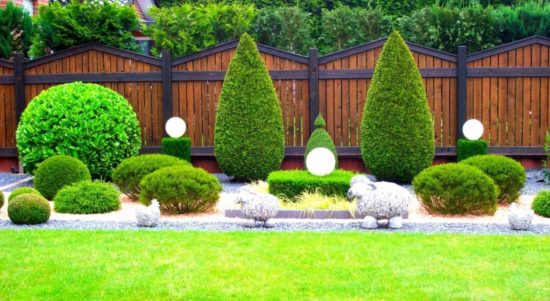
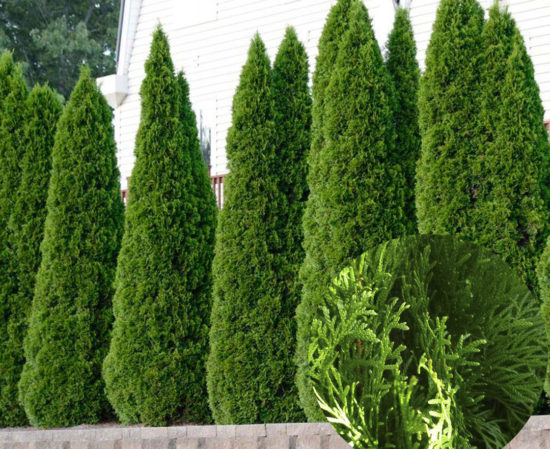
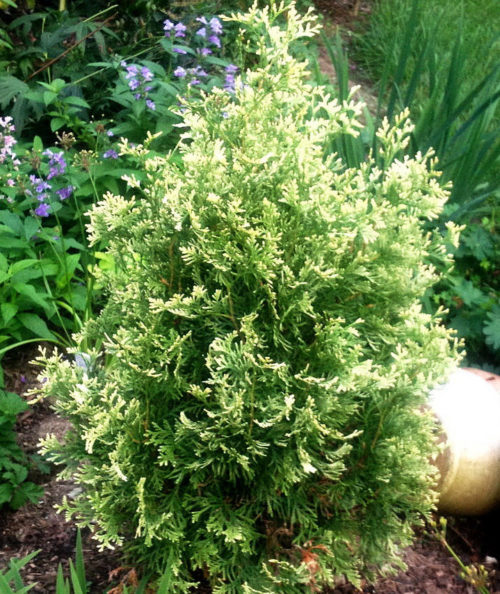
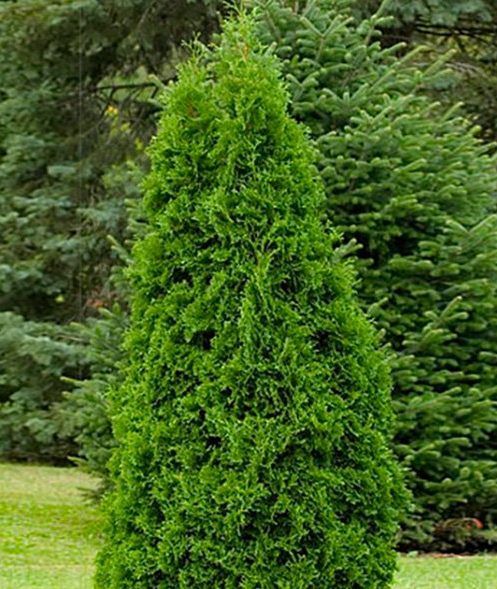
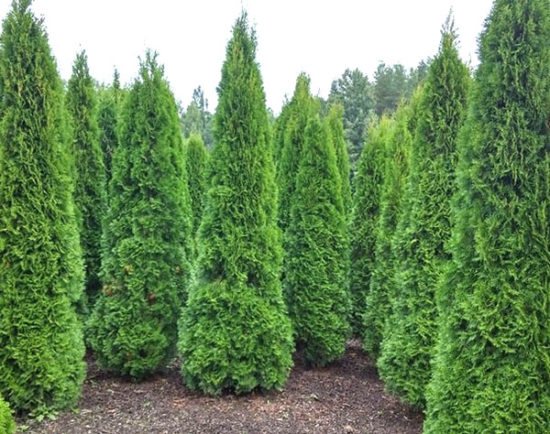
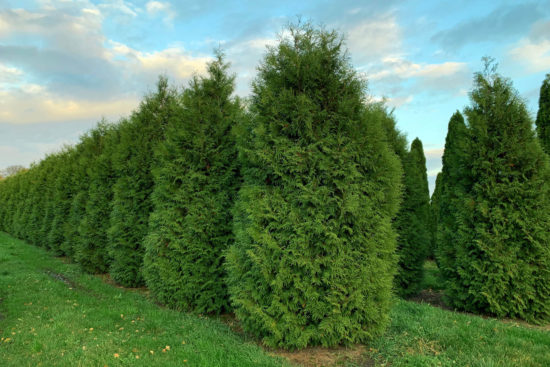
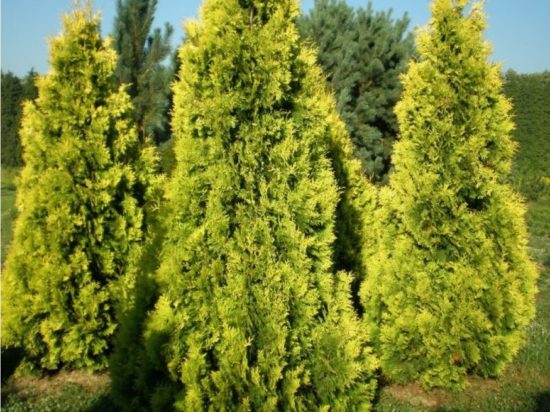
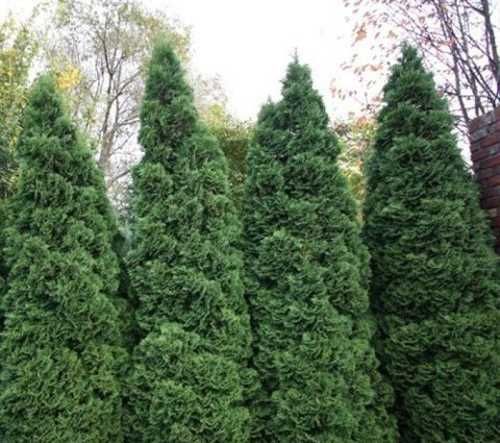
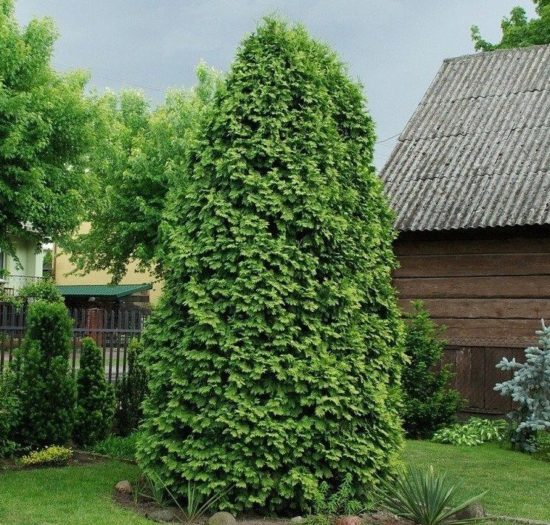
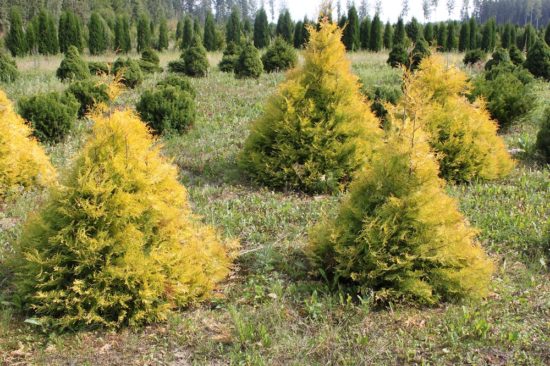
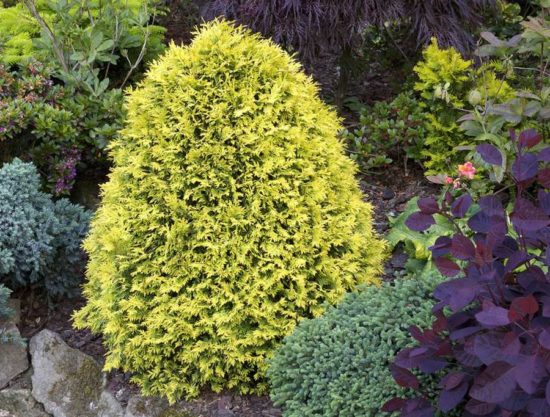
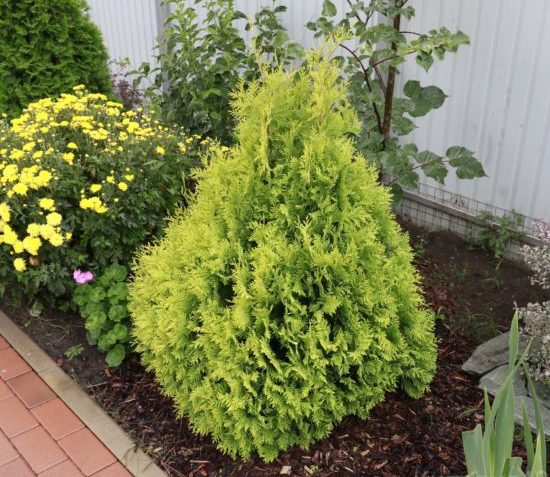

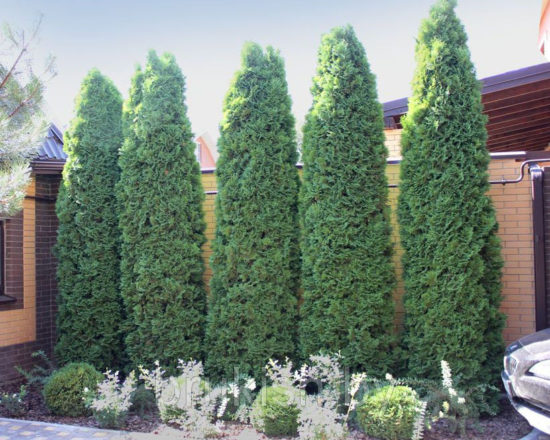

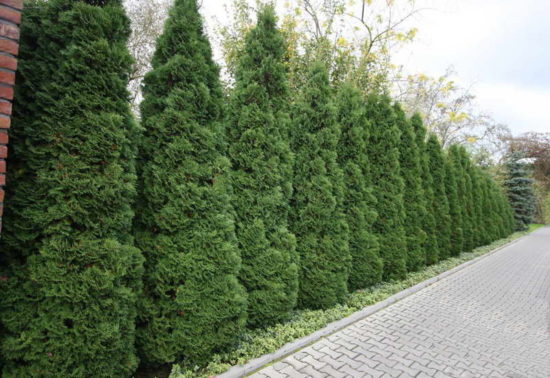
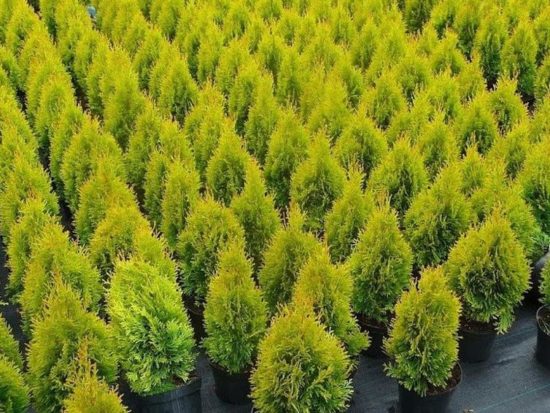
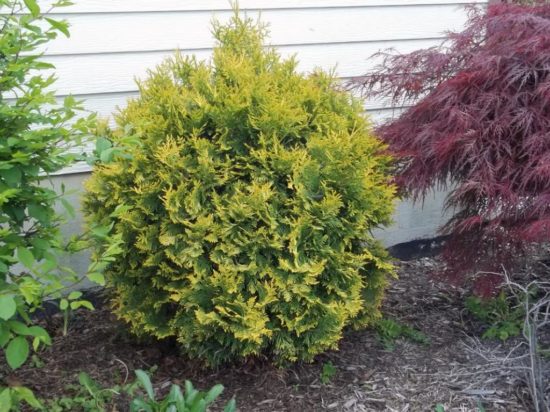
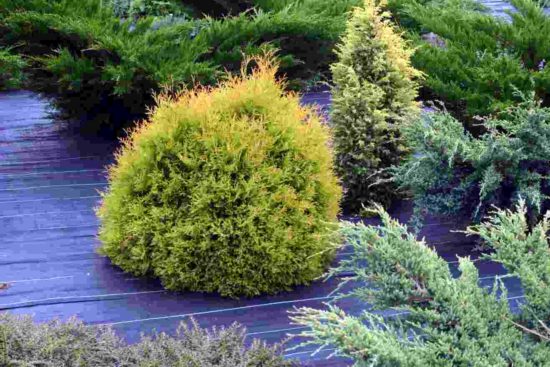
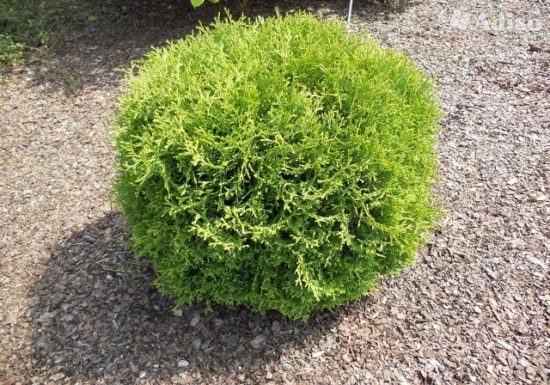
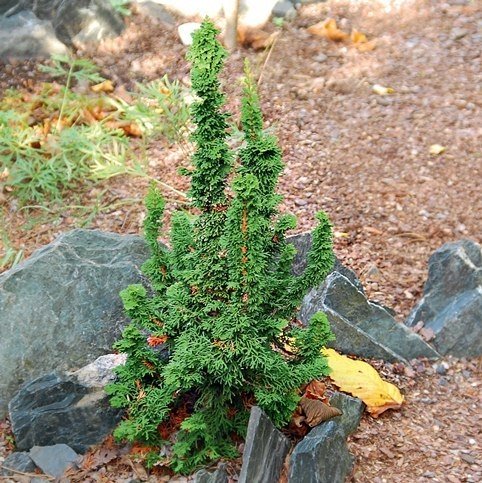
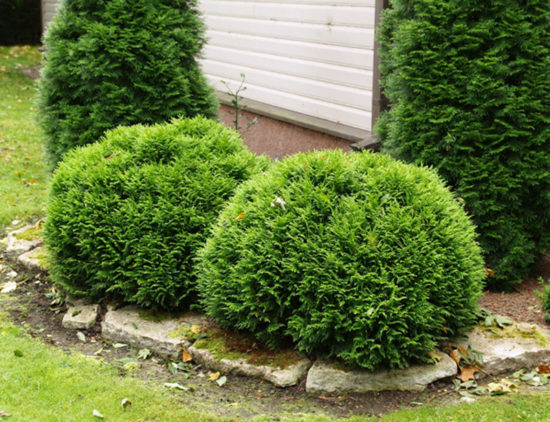
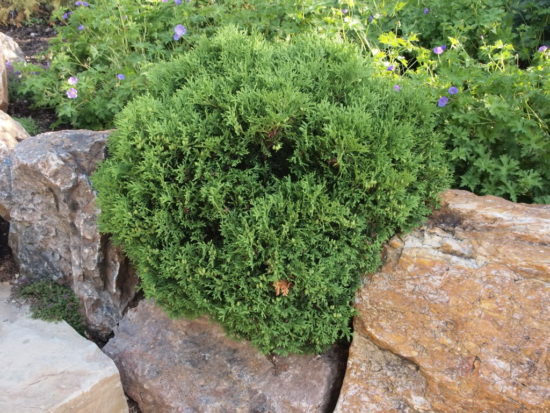

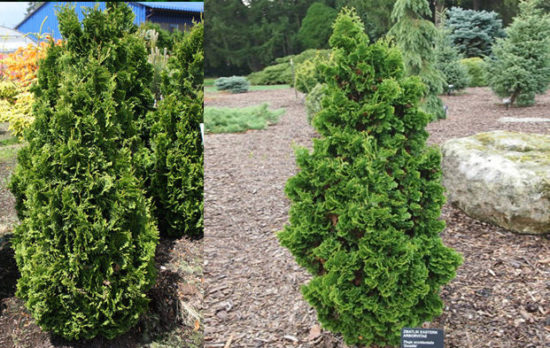
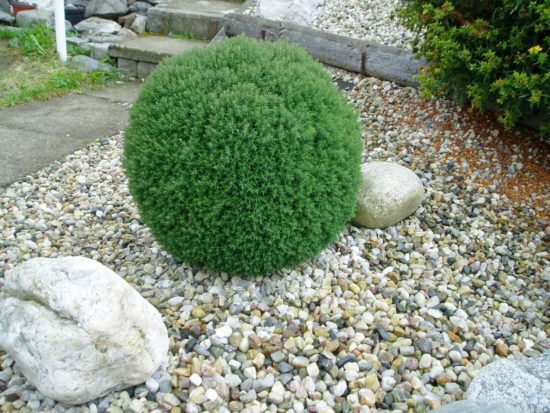
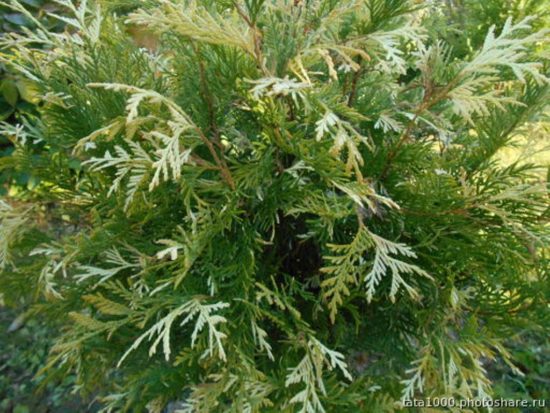
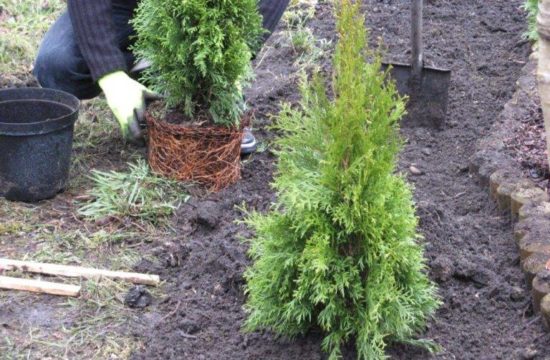

 CUCUMBERS NEVER GET SICK, I'VE BEEN USING ONLY THIS FOR 40 YEARS! I SHARE A SECRET WITH YOU, CUCUMBERS ARE LIKE THE PICTURE!
CUCUMBERS NEVER GET SICK, I'VE BEEN USING ONLY THIS FOR 40 YEARS! I SHARE A SECRET WITH YOU, CUCUMBERS ARE LIKE THE PICTURE! You can dig a bucket of potatoes from each bush. Do you think these are fairy tales? Watch the video
You can dig a bucket of potatoes from each bush. Do you think these are fairy tales? Watch the video
 How our fellow gardeners work in Korea.There is a lot to learn and just fun to watch.
How our fellow gardeners work in Korea.There is a lot to learn and just fun to watch. Eye trainer. The author claims that with daily viewing, vision is restored. They don't charge money for views.
Eye trainer. The author claims that with daily viewing, vision is restored. They don't charge money for views. A 3-ingredient cake recipe in 30 minutes is better than Napoleon. Simple and very tasty.
A 3-ingredient cake recipe in 30 minutes is better than Napoleon. Simple and very tasty. Therapeutic exercises for cervical osteochondrosis. A complete set of exercises.
Therapeutic exercises for cervical osteochondrosis. A complete set of exercises. Which indoor plants match your zodiac sign?
Which indoor plants match your zodiac sign? What about them? Excursion to German dachas.
What about them? Excursion to German dachas.
Tall green thuja trees with flat branches located in different planes form continuous screens, limiting and shaping the space, forming closed landscape areas. The play of shades of color in folds and shading created by multidirectional branches makes the textured surface expressive, creating a stunning impression. Unpretentious plants tolerate pruning well and are great for creating dense hedges and all kinds of green shapes, designing rocky hills and driveways. Several types of thuja are grown in culture, on the basis of which breeders have developed many different varieties, which include columnar, pyramidal, spherical and cushion-shaped forms of different colors and shades. The greatest selection diversity is distinguished by the western, eastern and folded thujas.